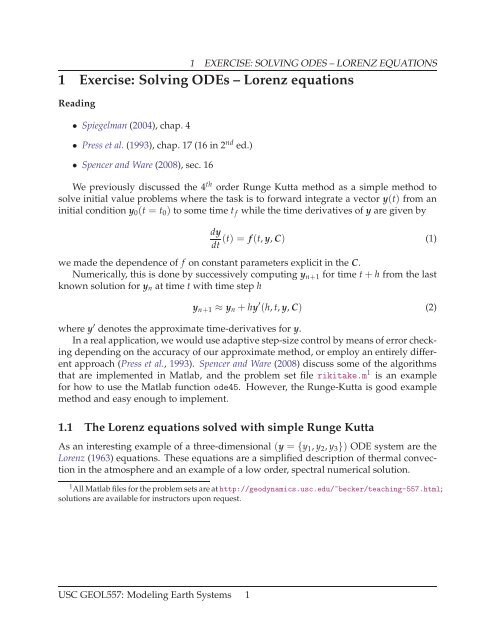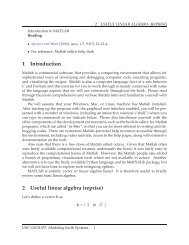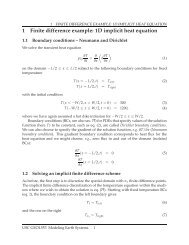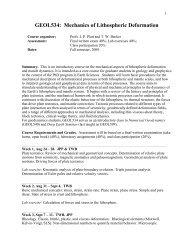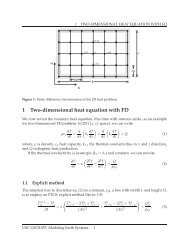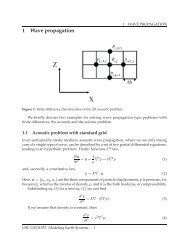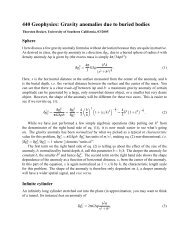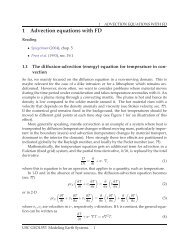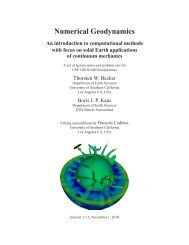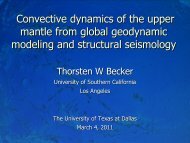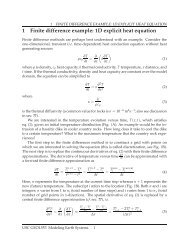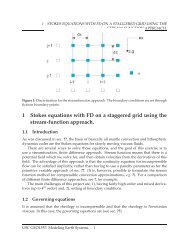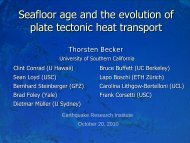1 Exercise: Solving ODEs â Lorenz equations - USC Geodynamics
1 Exercise: Solving ODEs â Lorenz equations - USC Geodynamics
1 Exercise: Solving ODEs â Lorenz equations - USC Geodynamics
You also want an ePaper? Increase the reach of your titles
YUMPU automatically turns print PDFs into web optimized ePapers that Google loves.
1 EXERCISE:SOLVINGODES –LORENZEQUATIONS<br />
1 <strong>Exercise</strong>: <strong>Solving</strong><strong>ODEs</strong>–<strong>Lorenz</strong><strong>equations</strong><br />
Reading<br />
• Spiegelman(2004),chap. 4<br />
• Pressetal.(1993), chap. 17(16 in 2 nd ed.)<br />
• Spencerand Ware(2008), sec. 16<br />
We previously discussed the 4 th order Runge Kutta method as a simple method to<br />
solve initial value problems where the task is to forward integrate a vector y(t) from an<br />
initial condition y 0 (t = t 0 ) to some time t f while the time derivatives of y are given by<br />
dy<br />
(t) = f(t,y,C) (1)<br />
dt<br />
we madethe dependenceof f on constant parameters explicitin the C.<br />
Numerically, this is done by successively computing y n+1 for time t +h from the last<br />
known solution for y n attime t with time step h<br />
y n+1 ≈ y n +hy ′ (h,t,y,C) (2)<br />
where y ′ denotes the approximate time-derivatives for y.<br />
Inarealapplication,wewoulduseadaptivestep-sizecontrolbymeansoferrorchecking<br />
dependingon the accuracy of our approximate method, or employ an entirely different<br />
approach (Press et al., 1993). Spencer and Ware (2008) discuss some of the algorithms<br />
that are implemented in Matlab, and the problem set file rikitake.m 1 is an example<br />
for how to use the Matlab function ode45. However, the Runge-Kutta is good example<br />
method and easyenough to implement.<br />
1.1 The<strong>Lorenz</strong> <strong>equations</strong> solved withsimple Runge Kutta<br />
As an interesting example of a three-dimensional (y = {y 1 ,y 2 ,y 3 }) ODE system are the<br />
<strong>Lorenz</strong> (1963) <strong>equations</strong>. These <strong>equations</strong> are a simplified description of thermal convection<br />
in the atmosphere and an exampleof alow order, spectral numerical solution.<br />
1 AllMatlabfilesfortheproblemsetsareathttp://geodynamics.usc.edu/~becker/teaching-557.html;<br />
solutions areavailablefor instructors uponrequest.<br />
<strong>USC</strong>GEOL557: ModelingEarth Systems 1
1 EXERCISE:SOLVINGODES –LORENZEQUATIONS<br />
1.2 Digression for background – not essential to solving this problem<br />
set<br />
For anincompressible fluid, conservation of mass, energy,and momentum for the convection problemcan<br />
bewritten as<br />
∇ ·v = 0 (3)<br />
∂T<br />
∂t +v·∇T = κ∇2 T (4)<br />
∂v<br />
∂t + (v · ∇)v = ν∇2 v − 1 ∇P + ρ g.<br />
ρ 0 ρ 0<br />
(5)<br />
Here, ν = η/ρ 0 is dynamic viscosity, v velocity, T temperature, κ thermal diffusivity, g gravitational acceleration,<br />
ρ density, and P pressure. In the Boussinesq approximation, ρ(T) = ρ 0 (1 − α(T −T 0 )), where α is<br />
thermal expansivityand ρ 0 and T 0 referencedensity andtemperature,respectively.<br />
If we assume two-dimensionality (2-D) in x and z direction, and a bottom-heated box of fluid, the<br />
box height d provides a typical length scale. If g only acts in z direction and all quantities are nondimensionalized<br />
by d, the diffusion time, d 2 /κ, and the temperature contrast between top and bottom<br />
∆T,we canwrite<br />
1<br />
Pr<br />
∂T ′<br />
∂t ′ +v ′ · ∇T ′ = ∇ 2 T ′ (6)<br />
( )<br />
∂ω<br />
∂t ′ +v ′ · ∇ω = ∇ 2 ω −Ra ∂T′<br />
∂x ′ , (7)<br />
where the primed quantities are non-dimensionalized (more on this later). Eq. (7) is eq. (5) rewritten in<br />
terms of vorticity ω,suchthat ∇ 2 ψ = −ω where ψ is the stream-function,whichrelatestovelocity as<br />
v = ∇ × ψk = {∂ψ/∂z, −∂ψ/∂x} (8)<br />
andenforcesincompressibility(massconservation). Theimportantpartherearethetwonewnon-dimensional<br />
quantities that arise, the Prandtl and the Rayleigh numbers, which were discussed previously (eqs. ?? and<br />
??).<br />
<strong>Lorenz</strong> (1963)used a very low orderspectral expansion to solve the convection <strong>equations</strong>. He assumed<br />
that<br />
ψ ≈ W(t)sin (πax)sin (πz) (9)<br />
T ≈ (1 −z) +T 1 (t)cos(πax)sin (πz) +T 2 (t)sin(2πz) (10)<br />
for convective cells with wavelength2/a. This is anexampleof a spectralmethod wherespatial variations<br />
in properties such as T are dealt with in the frequency domain, here with one harmonic. Such an analysis<br />
is alsocommon when examining barelysuper-criticalconvectiveinstabilities.<br />
1.3 Problems<br />
The resulting <strong>equations</strong> for the time dependent parameters of the approximate <strong>Lorenz</strong><br />
convection <strong>equations</strong>are<br />
dW<br />
dt<br />
dT 1<br />
dt<br />
dT 2<br />
dt<br />
= Pr(T 1 −W) (11)<br />
= −WT 2 +rW −T 1<br />
= WT 1 −bT 2<br />
<strong>USC</strong>GEOL557: ModelingEarth Systems 2
1 EXERCISE:SOLVINGODES –LORENZEQUATIONS<br />
where b = 4/(1 +a 2 ), r = Ra/Ra c with the critical Rayleigh number Ra c .<br />
1. IdentifyW, T 1 , and T 2 as y 1 ,y 2 ,y 3 and write up a Matlab code for a4 th orderRunge<br />
Kutta scheme to solve for the time-evolution of y usingeq. (11)forderivatives.<br />
Hint: You can code this anywayyou want, but considerthe following (Figure 2):<br />
• You will wantto separate a “driver” that dealswith initial conditions, controlling<br />
the total time steps, plotting, etc., and an actual routine that computes the<br />
Runge Kutta step following the formula we discussed in class. Those should<br />
be separate m-files, or atleastseparate functions.<br />
• YouwillwanttomaketheRungeKuttastepperindependentoftheactualfunctionthatisneededtocomputedy/dtsothatyoucanreuseitforotherproblems<br />
later. This can be done in Matlab by defining a function myfunc that computes<br />
the derivatives, and then passing the function name myfunc as an argument to<br />
the Runge Kutta time stepper. Within the time stepper, the function then then<br />
hasto be referred toas<br />
@func. Alternatively, the function that computes the derivatives can be made<br />
intoitsown “.m”file,inthe samedirectory astheothersubroutines, makingit<br />
available to allsubroutines in that folder.<br />
• Ifyouneedsomeinspirationonhowtodothis,downloadthem-filefragments<br />
we provide for thissections problem set,dydt.m, lorenz.m, andrkstep.m.<br />
2. Use initial condition y 0 = {0,0.5,0.5}, parameters b = 8/3, Pr = 10 and solve<br />
for time evolution for all three variables from t = 0 to t = 50, using a time step<br />
h = 0.005. Use r = 2 and plot T 1 and T 2 against time. Comment on the temporal<br />
character ofthe solution, whatdoesitcorrespond to physically?<br />
3. Change r to 10, and then 24. Plot T 1 and T 2 against time, and also plot the “phase<br />
space trajectory” of the system by plotting y in W, T 1 , and T 2 space using Matlab<br />
plot3. Commenton how these solutions differ.<br />
4. Increase r to 25 and plot both time behavior of T and the phase space trajectory.<br />
What happened? Compare the r = 25 solution with the r = 24 solution from the<br />
lastquestion. Doyouthinkr = 24willremainsteadyforalltimes? Why? Whynot?<br />
5. Use r = 30 and show on one plot how T 1 evolves with time for two different<br />
initial conditions, the y 0 from before, {0,0.5,0.5}, and a second initial condition<br />
{0,0.5,0.50001}. Comment.<br />
6. Compareyoursolution with h = 0.005for T 1 andaninitialcondition ofyourchoice<br />
inther = 30regimewiththeMatlab-internal<strong>ODEs</strong>olveryoudeemmostappropriate.<br />
Plot the absolute difference ofthe solutions against time. Comment.<br />
<strong>USC</strong>GEOL557: ModelingEarth Systems 3
1 EXERCISE:SOLVINGODES –LORENZEQUATIONS<br />
T 2<br />
50<br />
45<br />
40<br />
35<br />
30<br />
25<br />
20<br />
15<br />
10<br />
5<br />
0<br />
30<br />
20<br />
10<br />
T 1<br />
0<br />
−10<br />
−20<br />
−15<br />
−10<br />
−5<br />
0<br />
W<br />
5<br />
10<br />
15<br />
20<br />
Figure1: Solutiontooneoftheproblemsetquestionsvisualizingthebehaviorofthe<strong>Lorenz</strong><br />
<strong>equations</strong>(the<strong>Lorenz</strong>attractor).<br />
ForhelpwithmakingsimpleplotswithMatlab,seeSpencerandWare(2008),forexample.<br />
1.4 Additional examples<br />
1. IfyouarecuriousaboutadditionalEarthScienceapplicationsof<strong>ODEs</strong>,theliterature<br />
ofgeochemical modelingis full ofit because itis often easiest, or most appropriate,<br />
to consider fluxes between reservoirs of different chemical species with averages<br />
properties, so-called “box models” (e.g.Albarede,1995).<br />
2. Aclassicexamplefrommagneto-hydrodynamicsisthe3-DRikitakedynamomodel<br />
that consists of two conducting, coupled rotating disks in a background magnetic<br />
field. TheRikitakedynamoshowsbehaviorsimilartothe<strong>Lorenz</strong>systemandserves<br />
asan analogfor magneticfield reversal. The <strong>equations</strong>are<br />
dx<br />
dt<br />
dy<br />
dt<br />
dz<br />
dt<br />
= −mx +yz (12)<br />
= −my + (z −a)x<br />
= 1 −xy<br />
with typical parametersfor a of4or10, m = 2,atinitial conditions x,y,z = −5,2,2.<br />
<strong>USC</strong>GEOL557: ModelingEarth Systems 4
1 EXERCISE:SOLVINGODES –LORENZEQUATIONS<br />
function lorenz % this is only a function to allow function declarations<br />
%<br />
% Lorent’z equation solver<br />
% the ... parts will have to be filled in by you<br />
%<br />
% values to solve for<br />
%<br />
% y(1) : W<br />
% y(2) : T1<br />
% y(3) : T2<br />
% parameters for the <strong>equations</strong><br />
parameters.r = ...; % Rayleigh number<br />
parameters.Pr = ..; % Prandtl number<br />
% initial values<br />
y= [...];<br />
time =0;tstop=50;<br />
h = 0.005;% timestep<br />
save_each = 1;<br />
nstep=0;save_step=0;<br />
while(time < tstop) % loop while time is smaller than tstop<br />
if(mod(nstep,save_each)==0) % only save every save_each step<br />
save_step=save_step+1;<br />
ysave(save_step,:)=y;<br />
...<br />
end<br />
% advance the y(1:3) solution by one 4th order Runge Kutta step<br />
y = y + rkstep(....);<br />
nstep=nstep+1;<br />
time=time+h;<br />
end<br />
figure(1);clf % time series<br />
plot(tsave,ysave(:,2))<br />
xlabel(’time’);ylabel(’temperature’);<br />
legend(’T_1’,’T_2’)<br />
function dy = rkstep(.... )<br />
%<br />
%<br />
% perform one 4th order Runge Kutta timestep and return<br />
% the increment on y(t_n) by evaluating func(time,y,parameters)<br />
%<br />
% ... parts need to be filled in<br />
%<br />
%<br />
% input values:<br />
% h: time step<br />
% t: time<br />
% y: vector with variables at time = t which are to be advanced<br />
% func: function which computes dy/dt<br />
% parameters: structure with any parameters the func function might need<br />
% save computations<br />
h2=h/2;<br />
k1 = h .* dydt(...);<br />
k2 = h .* dydt(...);<br />
....<br />
% return the y_{n+1} timestep<br />
dy = ....<br />
function dydt = lorenz_dy(...)<br />
%<br />
% functions for Runge Kutta<br />
%<br />
%<br />
% dW/dt = Pr (T1-w)<br />
%<br />
dydt(1) = ...<br />
%<br />
% dT1/dt = -W T2 + rW - T1<br />
%<br />
dydt(2) = ...<br />
%<br />
% dT2/dt = W T1 - b T2<br />
%<br />
dydt(3) = ... x<br />
Figure 2: Suggested program structure for the <strong>Lorenz</strong> equation ODE solver exercise. Available<br />
online aslorenz.m,rkstep.m,anddydt.m.<br />
<strong>USC</strong>GEOL557: ModelingEarth Systems 5
1 EXERCISE:SOLVINGODES –LORENZEQUATIONS<br />
The file rikitake.m provides an example implementation of these <strong>equations</strong> using<br />
a MatlabODE solver.<br />
3. Examples from our own research where we have used simple ODE solutions, include<br />
some work on parameterized convection (Loyd et al., 2007), a method that<br />
goes back at least to Schubert et al. (1980), see Christensen (1985). In this case, the<br />
box is the mantle, and the total heat content of the mantle, as parameterized by the<br />
mean temperature, is the property one solves for. I.e. we are averaging the PDEs<br />
governing convection spatially, to solve for the time-evolution of average mantle<br />
temperature.<br />
The ideaisthat aconvective system with Rayleigh number<br />
Ra = ραTgh3<br />
κη<br />
(13)<br />
transports heatatNusselt number Nu following a scaling of<br />
Nu = Q cT = aRaβ (14)<br />
(withsomedebateabout β,see,e.g.Korenaga,2008,forareview). Theenergybalance<br />
for the mantle is<br />
dT<br />
C p = H(t) −Q (15)<br />
dt<br />
where C p is the total heat capacity, H the time-dependent heat production through<br />
radiogenic elements, and Q the heat loss through the surface. If viscosity is a function<br />
oftemperature,<br />
then the <strong>equations</strong>couple such that<br />
C p<br />
dT<br />
dt = H(t) −Q 0<br />
( H<br />
η = η 0 exp<br />
RT)<br />
(16)<br />
( ) T 1+β ( )<br />
η(T0 ) β<br />
. (17)<br />
T 0 η(T)<br />
Weprovideanexample,thermal_all.m online. Youmightwanttoexperimentwith<br />
the shooting method to explore feasible and unfeasable paths of Earth’s thermal<br />
evolution from an initial to afinal temperature.<br />
4. Anotherexample,fromthebrittleregime,arespringsliders. Insteadofdealingwith<br />
fullfaultdynamics,onemayconsiderablockthathasafrictionlawapplyatitsbase<br />
and pulled by a string. Depending on the assumptions on the friction law, such a<br />
system exhibits stick-slip behavior akin to the earthquake cycle. For rate-and-state<br />
(i.e. velocity and heal-time) dependent friction (e.g. Marone, 1998) with two “state”<br />
variables, spring-slider modelsexhibit interesting, chaotic behavior (Becker,2000).<br />
<strong>USC</strong>GEOL557: ModelingEarth Systems 6
1 EXERCISE:SOLVINGODES –LORENZEQUATIONS<br />
Figure 3: Poincare sections in y for the period doubling sequence to chaos for the springslider<br />
system,eq. (18), as a function of normalized spring stiffness, κ ′ . Bottomfigure shows<br />
zoom intothedashedrectangular regionhighlightedontop(modifiedfromBecker, 2000).<br />
The <strong>equations</strong>are<br />
ẋ = dx<br />
dt<br />
ẏ = dy<br />
dt<br />
ż = dz<br />
dt<br />
= e x ((β 1 −1)x +y−z) +ẏ−ż (18)<br />
= (1 −e x )κ<br />
= −e x ρ(β 2 x +z)<br />
with β 1 = 1, β 2 = 0.84,and ρ = 0.048(Guetal., 1984).<br />
Thisbehaviorincludesthecharacteristicperiod-doublingroutetowardchaos(Feigenbaum,<br />
1978) as a function of a material parameter (spring stiffness), at critical κ =<br />
0.08028(Becker,2000). You mightwanttoreproduce thebifurcation plotofFigure 3.<br />
<strong>USC</strong>GEOL557: ModelingEarth Systems 7
BIBLIOGRAPHY<br />
Bibliography<br />
Albarede,F. (1995), Introduction togeochemicalmodeling,Cambridge University Press.<br />
Becker, T. W. (2000), Deterministic chaos in two state-variable friction sliders and the effectofelasticinteractions,inGeoComplexityandthephysicsofearthquakes,Geophys.Monograph,vol.<br />
120, edited by J. B. Rundle,D. L. Turcotte, and W. Klein, pp. 5–26,American<br />
Geophysical Union, Washington, DC.<br />
Christensen, U. R. (1985), Thermal evolution models for the Earth, J. Geophys. Res., 90,<br />
2995–3007.<br />
Feigenbaum, M. J. (1978), Quantitative universality for a class of nonlinear transformations,<br />
J. Stat. Phys.,19, 25.<br />
Gu, J.-C., J. R. Rice, A. L. Ruina, and S. T. Tse (1984), Slip motion and stability of a single<br />
degree of freedom elastic system with rate and state dependent friction, J. Mech. Phys.<br />
Solids,32,167–196.<br />
Korenaga, J. (2008), Urey ratio and the structure and evolution of Earth’s mantle, Rev.<br />
Geophys.,46, doi:10.1029/2007RG000241.<br />
<strong>Lorenz</strong>, E. N.(1963), Deterministic nonperiodic flow,J. Atmos. Sci.,20, 130.<br />
Loyd, S. J., T. W. Becker, C. P. Conrad, C. Lithgow-Bertelloni, and F. A. Corsetti (2007),<br />
Time-variability in Cenozoic reconstructions of mantle heat flow: plate tectonic cycles<br />
andimplications forEarth’sthermal evolution, Proc.Nat. Acad.Sci.,104,14,266–14,271.<br />
Marone,C.(1998),Laboratory-derivedfrictionlawsandtheirapplicationtoseismicfaulting,<br />
Annu. Rev.Earth Planet. Sci.,26,643–696.<br />
Press, W.H.,S.A.Teukolsky, W.T.Vetterling, andB.P.Flannery(1993),NumericalRecipes<br />
inC: TheArtof ScientificComputing, 2ed., Cambridge UniversityPress, Cambridge.<br />
Schubert,G.,D.Stevenson,andP.Cassen(1980),Wholeplanetcoolingandtheradiogenic<br />
heatsource contents ofthe Earth and Moon, J. Geophys.Res., 85,2531–2538.<br />
Spencer, R. L., and M. Ware (2008), Introduction to Matlab, Brigham Young University,<br />
availableonline, accessed 07/2008.<br />
Spiegelman, M. (2004), Myths and Methods in Modeling,<br />
Columbia University Course Lecture Notes, available online at<br />
http://www.ldeo.columbia.edu/~mspieg/mmm/course.pdf, accessed 06/2006.<br />
<strong>USC</strong>GEOL557: ModelingEarth Systems 8


